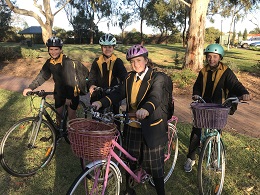16 May 2019
 It’s sobering to realise that less than 20 per cent of children in Australia get the recommended amount of physical exercise each day.
It’s sobering to realise that less than 20 per cent of children in Australia get the recommended amount of physical exercise each day.
While this statistic has prompted calls for a range of solutions, from more sport in school to more sport outside school, simply getting to and from school could offer one of the best answers.
Incidental activity – that is, the exercise you get just going about your daily business – is a key part of children staying healthy, and as Professor Tim Olds from the University of South Australia explains, rethinking the trip to school can make a big difference.
“There’s quite a bit of data about the importance of this sort of activity, particularly in relation to active transport, which is basically walking or riding,” Prof Olds says.
“When it comes to everyday activities, walking or riding to school is a big-ticket item. But even the simple act of walking to school has been declining at a rate of about 2 to 3 per cent a year for the past 20 years or so.”
The reasons for this decline are more complicated than many people might assume, with structural issues as much to blame as apathy, laziness or stranger-danger anxiety.
“In part, it’s simply that people are living further from their schools. We know the closer a child lives to the school, the more likely they are to walk or ride. The mid-point is about 800 metres – if the school is 800 metres away, they are equally likely to walk or ride as they are to get a lift.”
Mount Carmel College teacher and mother of two, Tania Daniele, says her daughter Ava has recently started riding to high school, travelling around 3km to and from school each day. She says making the change has been a process over time, and it has had a huge impact on Ava’s health and self-confidence.
“Learning independence is all about gradually extending boundaries, but in manageable small steps,” Daniele says.
“Ava was very keen to ride to school, and we wanted to support this, but we also wanted to make sure she felt safe and confident.
“To prepare, we practised navigating the local streets, finding the best route and, of course, general road and personal safety.
“On the first few goes, she rode with her dad. Now, she’s riding with a group of friends, meeting them en route and then riding to school as a group. It’s great for her confidence, fitness and sense of freedom.”
Active Healthy Kids Australia recommend children and young people need at least 60 minutes of moderate to vigorous physical activity each day, the more the better, with shorter bursts of activity counting towards the overall tally.
Optimistically, Daniele thinks the message may be getting through to a new generation of school kids.
“As a teacher, we’ve been seeing more younger kids riding to school – the new year sevens, many of whom are starting high school for the first time in SA this year – so much so that some schools are even getting more bike racks installed.
“So, perhaps there’s a change coming.”
....................................................................................................................................................................................
Media: Annabel Mansfield: office +61 8 8302 0351 | mobile: +61417 717 504
email: Annabel.Mansfield@unisa.edu.au
Media:Dan Lander office +61 8 8302 0578 | mobile:+61 408 882 809
email: dan.lander@unisa.edu.au



